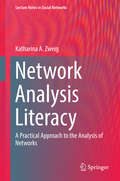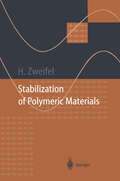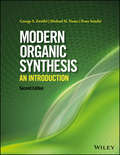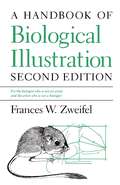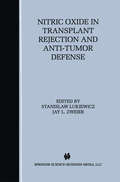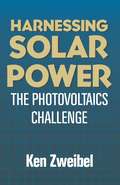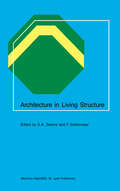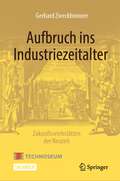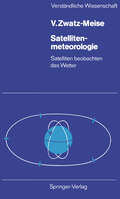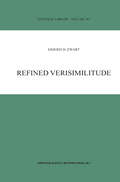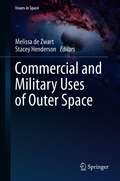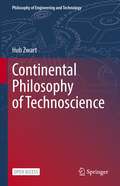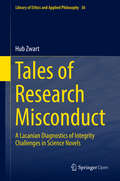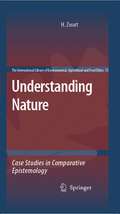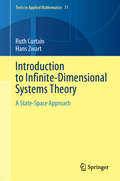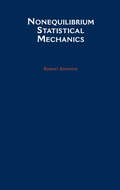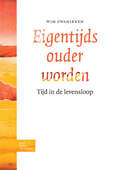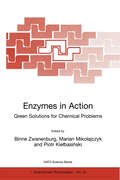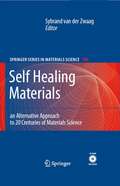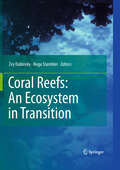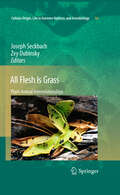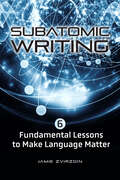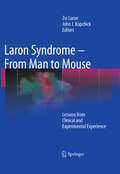- Table View
- List View
Network Analysis Literacy: A Practical Approach to the Analysis of Networks (Lecture Notes in Social Networks)
by Katharina A. ZweigThis book presents a perspective of network analysis as a tool to find and quantify significant structures in the interaction patterns between different types of entities. Moreover, network analysis provides the basic means to relate these structures to properties of the entities. It has proven itself to be useful for the analysis of biological and social networks, but also for networks describing complex systems in economy, psychology, geography, and various other fields. Today, network analysis packages in the open-source platform R and other open-source software projects enable scientists from all fields to quickly apply network analytic methods to their data sets. Altogether, these applications offer such a wealth of network analytic methods that it can be overwhelming for someone just entering this field. This book provides a road map through this jungle of network analytic methods, offers advice on how to pick the best method for a given network analytic project, and how to avoid common pitfalls. It introduces the methods which are most often used to analyze complex networks, e.g., different global network measures, types of random graph models, centrality indices, and networks motifs. In addition to introducing these methods, the central focus is on network analysis literacy – the competence to decide when to use which of these methods for which type of question. Furthermore, the book intends to increase the reader's competence to read original literature on network analysis by providing a glossary and intensive translation of formal notation and mathematical symbols in everyday speech. Different aspects of network analysis literacy – understanding formal definitions, programming tasks, or the analysis of structural measures and their interpretation – are deepened in various exercises with provided solutions. This text is an excellent, if not the best starting point for all scientists who want to harness the power of network analysis for their field of expertise.
Stabilization of Polymeric Materials (Macromolecular Systems - Materials Approach)
by Hans ZweifelPlastics are used worldwide in everyday life, e.g. as food packaging, electronics, construction, automotive parts, and household appliances. To produce these products with the desired service lifetimes the use of suitable stabilizers is necessary. This book provides a concise and comprehensive overview of the basic mechanisms of plastic degradation processes caused by heat and light. At its core is a detailed description of the stabilization of different polymers, including an explanation of stabilization mechanisms and the influence of commonly used additives such as fillers, flame retardents and pigments on the stability of plastic. Every polymer scientist, material technologist, or application engineer dealing with the design of the properties of plastics will benefit from this new overview.
Modern Organic Synthesis: An Introduction
by George S. Zweifel Michael H. Nantz Peter SomfaiThis book bridges the gap between sophomore and advanced / graduate level organic chemistry courses, providing students with a necessary background to begin research in either an industry or academic environment. • Covers key concepts that include retrosynthesis, conformational analysis, and functional group transformations as well as presents the latest developments in organometallic chemistry and C–C bond formation• Uses a concise and easy-to-read style, with many illustrated examples• Updates material, examples, and references from the first edition• Adds coverage of organocatalysts and organometallic reagents
Modern Organic Synthesis: An Introduction
by George S. Zweifel Michael H. Nantz Peter SomfaiThis book bridges the gap between sophomore and advanced / graduate level organic chemistry courses, providing students with a necessary background to begin research in either an industry or academic environment. • Covers key concepts that include retrosynthesis, conformational analysis, and functional group transformations as well as presents the latest developments in organometallic chemistry and C–C bond formation• Uses a concise and easy-to-read style, with many illustrated examples• Updates material, examples, and references from the first edition• Adds coverage of organocatalysts and organometallic reagents
A Handbook of Biological Illustration (Chicago Guides to Writing, Editing, and Publishing)
by Frances W. ZweifelThis book is designed to help biologists who must create their own illustrations and artists who are confronted with unfamiliar biological subjects. The author, an experienced biological illustrator, gives practical instructions and advice on the consideration of size and of printing processes, choice of materials, methods for saving time and labor, drawing techniques, lettering methods, and mounting and packing the finished illustrations. She explains how to produce clear and attractive charts, graphs, and maps, so essential to science publications. Though this primer does not cover photographic techniques, it does include advice on retouching, cropping, and mounting photographs and on using photographs of biological subjects as aids in drawing. This second edition is updated to reflect the many technological changes in art materials and printing processes that have occurred since the book's first publication, and it includes an entirely new chapter on planning, designing, and mounting the poster presentations that have become an essential part of conferences held by scientific societies. Also included are the requirements and conventions peculiar to biological illustration and a bibliography of useful reference works. "Every biology student who intends to write a thesis deserves to own this book, as does the biologist who intends to publish or work up some visual aids for his own use. There is no reason to limit the concepts of this handbook to the field of biology; it should be useful to other specific areas of science."—Evan Lindquist, American Biology Teacher (from a review of the first edition)
Nitric Oxide in Transplant Rejection and Anti-Tumor Defense
by Jay L. Zweier StanislawLukiewiczNitric Oxide in Transplant Rejection and Anti-Tumor Defense represents a unique combination of three interrelated topics that is unavailable in any other single work: The detection and visualization of nitric oxide in biological materials using EPR spectroscopy and EPR imaging; Nitric oxide in immune mechanisms of allograft rejection; and The involvement of nitric oxide in anti-tumor defense. By bringing together specialists from these three disciplines, the book investigates the common molecular and cellular mechanisms underlying phenomena in transplants and oncology. In addition, the book provides an introduction to biological applications of EPR spectroscopy and imaging. Nitric Oxide in Transplant Rejection and Anti-Tumor Defense will appeal to researchers and graduate-level students investigating transplant rejections and their immune mechanisms, anti-tumor immune defenses, novel types of contrast agents for EPR imaging, and biological applications of EPR spectroscopy and EPR imaging.
Aufbruch ins Industriezeitalter – Zukunftswerkstätten der Neuzeit
by Gerhard ZweckbronnerWir leben in einer von Technik geprägten Welt. Dieses Sachbuch möchte ein Grundverständnis für technische Funktionsweisen und Zusammenhänge vermitteln. Es zeigt historische Entwicklungswege bis in die Gegenwart auf und macht deutlich, vor welche Entscheidungen wir heute gestellt sind. Wer sich in unserer hochtechnisierten Welt besser orientieren möchte, dem könnte ein Blick in die Zukunftswerkstätten der Vergangenheit helfen: jener Zeiten des Aufbruchs, in denen, ausgehend vom europäischen Kulturkreis, die mentalen und wissenschaftlich-technischen Grundlagen unserer modernen Lebenswelt geschaffen wurden. Kühne Fortschrittserwartungen, weit ausgreifende Visionen, aber auch warnende Stimmen begleiten die Entwicklung bis zum heutigen Tag.
Satellitenmeteorologie: Satelliten beobachten das Wetter (Verständliche Wissenschaft #117)
by Veronika Zwatz-MeiseRefined Verisimilitude (Synthese Library #307)
by S.D. ZwartThe subject of the present inquiry is the approach-to-the-truth research, which started with the publication of Sir Karl Popper's Conjectures and Refutations. In the decade before this publication, Popper fiercely attacked the ideas of Rudolf Carnap about confirmation and induction; and ten years later, in the famous tenth chapter of Conjectures he introduced his own ideas about scientific progress and verisimilitude (cf. the quotation on page 6). Abhorring inductivism for its apprecia tion of logical weakness rather than strength, Popper tried to show that fallibilism could serve the purpose of approach to the truth. To substantiate this idea he formalized the common sense intuition about preferences, that is: B is to be preferred to A if B has more advantages andfewer drawbacks than A. In 1974, however, David Millerand Pavel Tichy proved that Popper's formal explication could not be used to compare false theories. Subsequently, many researchers proposed alternatives or tried to improve Popper's original definition.
Commercial and Military Uses of Outer Space (Issues in Space)
by Melissa De Zwart Stacey HendersonThis edited book brings together a diverse range of chapters on space related topics. The authors included in this book are drawn from Australia and overseas, from academia, government, industry, civil society and the military. This book contains chapters that cover topics such as law, science, archaeology, defence, policy, and more, all with a focus on space. This edited collection is a timely international and interdisciplinary book, which addresses some of the contemporary issues facing activities in space and those attempting to understand, use and regulate the space domain. This edited book seeks to normalise the role of women as experts in the space sector, by not calling attention to the fact that all the authors are women – they are all experts in their respective fields who just happen to be women. Bringing together these contributions in this book in turn promotes the inclusion of diversity in the space sector. This edited collection is an opportunity to influence the development of the space industry – in terms of gender diversity, and diversity of disciplines and thinking – while it is in its formative stage, rather than trying to redress imbalances once they are entrenched in the industry.
Continental Philosophy of Technoscience (Philosophy of Engineering and Technology #38)
by Hub ZwartThe key objective of this volume is to allow philosophy students and early-stage researchers to become practicing philosophers in technoscientific settings. Zwart focuses on the methodological issue of how to practice continental philosophy of technoscience today. This text draws upon continental authors such as Hegel, Engels, Heidegger, Bachelard and Lacan (and their fields of dialectics, phenomenology and psychoanalysis) in developing a coherent message around the technicity of science or rather, “technoscience”. Within technoscience, the focus will be on recent developments in life sciences research, such as genomics, post-genomics, synthetic biology and global ecology. This book uniquely presents continental perspectives that tend to be underrepresented in mainstream philosophy of science, yet entail crucial insights for coming to terms with technoscience as it is evolving on a global scale today.This is an open access book.
Tales of Research Misconduct: A Lacanian Diagnostics of Integrity Challenges in Science Novels (Library of Ethics and Applied Philosophy #36)
by Hub ZwartThis monograph contributes to the scientific misconduct debate from an oblique perspective, by analysing seven novels devoted to this issue, namely: Arrowsmith by Sinclair Lewis (1925), The affair by C.P. Snow (1960), Cantor’s Dilemma by Carl Djerassi (1989), Perlmann’s Silence by Pascal Mercier (1995), Intuition by Allegra Goodman (2006), Solar by Ian McEwan (2010) and Derailment by Diederik Stapel (2012). Scientific misconduct, i.e. fabrication, falsification, plagiarism, but also other questionable research practices, have become a focus of concern for academic communities worldwide, but also for managers, funders and publishers of research. The aforementioned novels offer intriguing windows into integrity challenges emerging in contemporary research practices. They are analysed from a continental philosophical perspective, providing a stage where various voices, positions and modes of discourse are mutually exposed to one another, so that they critically address and question one another. They force us to start from the admission that we do not really know what misconduct is. Subsequently, by providing case histories of misconduct, they address integrity challenges not only in terms of individual deviance but also in terms of systemic crisis, due to current transformations in the ways in which knowledge is produced. Rather than functioning as moral vignettes, the author argues that misconduct novels challenge us to reconsider some of the basic conceptual building blocks of integrity discourse.Except where otherwise noted, this book is licensed under a Creative Commons Attribution 4.0 International License. To view a copy of this license, visit http://creativecommons.org/licenses/by/4.0/.
Understanding Nature: Case Studies in Comparative Epistemology (The International Library of Environmental, Agricultural and Food Ethics #13)
by Hub ZwartScience is not the only route to understanding nature. This volume presents a series of case studies in comparative epistemology, critically comparing the works of prominent representatives of the life sciences, such as Aristotle, Darwin, and Mendel, with the writings of literary masters, such as Andersen, Melville, Verne, and Ibsen. It constitutes a major contribution to the growing field of science and literature studies.
Introduction to Infinite-Dimensional Systems Theory: A State-Space Approach (Texts in Applied Mathematics #71)
by Hans Zwart Ruth CurtainInfinite-dimensional systems is a well established area of research with an ever increasing number of applications. Given this trend, there is a need for an introductory text treating system and control theory for this class of systems in detail. This textbook is suitable for courses focusing on the various aspects of infinite-dimensional state space theory. This book is made accessible for mathematicians and post-graduate engineers with a minimal background in infinite-dimensional system theory. To this end, all the system theoretic concepts introduced throughout the text are illustrated by the same types of examples, namely, diffusion equations, wave and beam equations, delay equations and the new class of platoon-type systems. Other commonly met distributed and delay systems can be found in the exercise sections. Every chapter ends with such a section, containing about 30 exercises testing the theoretical concepts as well. An extensive account of the mathematical background assumed is contained in the appendix.
Nonequilibrium Statistical Mechanics
by Robert ZwanzigThis is a presentation of the main ideas and methods of modern nonequilibrium statistical mechanics. It is the perfect introduction for anyone in chemistry or physics who needs an update or background in this time-dependent field. Topics covered include fluctuation-dissipation theorem; linear response theory; time correlation functions, and projection operators. Theoretical models are illustrated by real-world examples and numerous applications such as chemical reaction rates and spectral line shapes are covered. The mathematical treatments are detailed and easily understandable and the appendices include useful mathematical methods like the Laplace transforms, Gaussian random variables and phenomenological transport equations.
Eigentijds ouder worden: Tijd in de levensloop
by Wim ZwanikkenGedurende de menselijke levensloop heeft de psychologische tijd vele vormen en gedaanten. Heden, verleden en toekomst, haast en verveling, depressie en vreugde, arbeid en inspanning kennen alle hun bijbehorende tijdsvormen. De mens doet iets met tijd; de tijd doet ook steeds iets met de mens. Op zoek naar de betekenis van zijn levensloop stuit de mens zowel op zijn afkomst waar hem het leven is geschonken als op zijn bestemming waar voltooiing tevens het einde betekent.
Enzymes in Action Green Solutions for Chemical Problems (NATO Science Partnership Subseries: 1 #33)
by Binne Zwanenburg Marian Mikolajczyk Piotr KielbasinskiEnzymes in Action is a timely survey of a modern development in organic chemistry. It is clear that bioreagents demand that organic chemists think in a different way. If they do so, they will open up new avenues of exciting, new chemistry that will permit problems to be solved in an elegant way. The first section covers the concepts necessary to understand enzymes in molecular operations. The second section covers heteroatom enzyme chemistry, with considerable attention being given to the use of enzymes in the detoxification of chemical warfare agents and their application in environmental problems. The final section highlights the strategic use of enzymes in organic chemistry. It is clear that the term `green chemistry' is appropriate, since enzyme mediated processes occur under mild, environmentally benign conditions, and enzymes enable chemists to perform new chemical operations that would otherwise be difficult to achieve at all.
Self Healing Materials: An Alternative Approach to 20 Centuries of Materials Science (Springer Series in Materials Science #100)
by Sybrand Van Der ZwaagThis book, the first published in this new sub-field of materials science, presents a coherent picture of the design principles and resulting properties of self-healing materials over all material classes, and offsets them to the current design principles for structural materials with improved mechanical properties. The book is not only a valuable asset for professional materials scientists but it is also suitable as a text book for courses at MSc level.
Coral Reefs: An Ecosystem in Transition
by Zvy Dubinsky and Noga StamblerThis book covers in one volume materials scattered in hundreds of research articles, in most cases focusing on specialized aspects of coral biology. In addition to the latest developments in coral evolution and physiology, it presents chapters devoted to novel frontiers in coral reef research. These include the molecular biology of corals and their symbiotic algae, remote sensing of reef systems, ecology of coral disease spread, effects of various scenarios of global climate change, ocean acidification effects of increasing CO2 levels on coral calcification, and damaged coral reef remediation. Beyond extensive coverage of the above aspects, key issues regarding the coral organism and the reef ecosystem such as calcification, reproduction, modeling, algae, reef invertebrates, competition and fish are re-evaluated in the light of new research and emerging insights. In all chapters novel theories as well as challenges to established paradigms are introduced, evaluated and discussed. This volume is indispensible for all those involved in coral reef management and conservation.
All Flesh Is Grass: Plant-Animal Interrelationships (Cellular Origin, Life in Extreme Habitats and Astrobiology #16)
by Zvy Dubinsky and Joseph SeckbachThis new book takes us through a journey from early life to modern agriculture. The thirty eight authors present current studies on the interrelation of plants-animals. This topic has always fascinated man, as evidenced even by the first chapters of Genesis. The world of aqueous and terrestrial fauna appeared on early earth only after the flora covered the areas with the green pigmentation. Almost all life depends upon sunlight via the photosynthesis of the botanical world. We read abut the harnessing of bee pollination of crops to make it an essential component of modern agriculture endeavor. Some plants seduce insects for pollination by their appearance (e.g., disguised orchids entice visitors); there is the production of sweet nectar as a bribe in flowers to attract bees, butterflies, and honey-sucking birds. A particular outstanding phenomena are the carnivorous plants that have developed trapping and digesting systems of insects and higher animals.
Subatomic Writing: Six Fundamental Lessons to Make Language Matter
by Jamie ZvirzdinSee science writing fundamentals afresh through a subatomic lens!In Subatomic Writing, Johns Hopkins University instructor Jamie Zvirzdin goes bravely into uncharted territory by offering a totally new kind of guide for writing about science—from the subatomic level up! Subatomic Writing teaches readers that the building blocks of language are like particles in physics. These particles, combined and arranged, form something greater than their parts: all matter in the literary universe. The six levels of language covered in this guide create writing that illuminates and energizes the reader to feel, learn, change, and act. This interdisciplinary approach helps scientists, science writers, and editors improve their writing in fundamental areas as they build from the sounds in a word to the pacing of a paragraph. These areas include• Sound and sense• Word classes• Grammar and syntax• Punctuation• Rhythm and emphasis• Pacing and coherenceEqually helpful for students who need to learn how to write clearly about science and scientists who need to hone their writing skills to create more effective course material, papers, and grant applications, this guide builds confidence in writing abilities as old skills are taught in new, exciting ways. Each lesson provides exercises that build on each other, strengthening readers' capacity to communicate ideas and data, all while learning basic particle physics along the way.
Subatomic Writing: Six Fundamental Lessons to Make Language Matter
by Jamie ZvirzdinSee science writing fundamentals afresh through a subatomic lens!In Subatomic Writing, Johns Hopkins University instructor Jamie Zvirzdin goes bravely into uncharted territory by offering a totally new kind of guide for writing about science—from the subatomic level up! Subatomic Writing teaches readers that the building blocks of language are like particles in physics. These particles, combined and arranged, form something greater than their parts: all matter in the literary universe. The six levels of language covered in this guide create writing that illuminates and energizes the reader to feel, learn, change, and act. This interdisciplinary approach helps scientists, science writers, and editors improve their writing in fundamental areas as they build from the sounds in a word to the pacing of a paragraph. These areas include• Sound and sense• Word classes• Grammar and syntax• Punctuation• Rhythm and emphasis• Pacing and coherenceEqually helpful for students who need to learn how to write clearly about science and scientists who need to hone their writing skills to create more effective course material, papers, and grant applications, this guide builds confidence in writing abilities as old skills are taught in new, exciting ways. Each lesson provides exercises that build on each other, strengthening readers' capacity to communicate ideas and data, all while learning basic particle physics along the way.
Laron Syndrome - From Man to Mouse: Lessons from Clinical and Experimental Experience
by Zvi Laron and J. KopchickLaron syndrome (LS), or primary growth hormone (GH) insensitivity, was first described in 1966. Since then, many patients worldwide have been diagnosed with LS, which involves defects in the GH receptor that cause combined congenital deficiency of GH and IGF-I activities. In this comprehensive book the authors draw upon 50 years of multidisciplinary clinical and investigative follow-up of the large Israeli cohort of LS patients. The genetic basis of the syndrome is fully considered, and all aspects of the pathophysiology of IGF-I deficiency are described. Data derived from the recently generated mouse model of LS are reviewed and compared with the human LS experience. Valuable advice is provided on treatment, and treatment effects, such as metabolic effects, adipose tissue alterations, and impact on aging, are fully explored. Together, this book condenses, consolidates, compares, and contrasts data derived from the human and mouse LS experiences and provides a unique resource for clinical and basic scientists to evaluate and compare IGF-I and GH actions.
